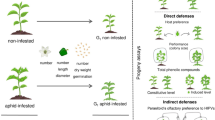Summary
Undamaged foliage of sixteen species of broadleaved trees was assessed for background (constitutive) palatability using larvae of Spodoptera littoralis (Lepidoptera) in laboratory bioassays. Palatability (dry weight consumed in 48 h) varied significantly between species and exhibited a four-fold range. Leaves of fifteen species were damaged artificially in the field and offered with control (undamaged) leaves to Spodoptera after 48 h and two weeks on the tree. Leaves adjacent to the damaged ones were similarly tested. Ten species exhibited significant (P<0.02) wound induced declines in palatability; damaged and adjacent foliage was involved. Although there was no significant relationship between the trees' constitutive palatability and the number of invertebrate herbivore species they support, this previously-demonstrated relationship closely approached significance when the species showing wound-induced effects were excluded from the regression. These results are discussed within the limitations of laboratory bioassays and the possible field consequences are briefly considered.
Similar content being viewed by others
References
Cates RG, Orians GH (1975) Successional status and palatability of plants to generalised herbivores. Ecology 56:410–418
Edwards PJ, Wratten SD (1985) Induced plant defences against insect grazing: fact or artefact? Oikos 44:70–74
Edwards PJ, Wratten SD, Cox H (1985) Wound-induced changes in the acceptability of tomato to larvae of Spodoptera littoralis: a laboratory bioassay. Ecol Ent 10:155–158
Jennings STJ, Barkham JO (1975) Food of slugs in mixed deciduous woodland. Oikos 26:211–221
Levin DA (1971) Plant phenolics: an ecological perspective. Amer Natur 105:157–181
Maiorana VC (1978) What kinds of plants do herbivores really prefer? Amer Natur 112:631–635
Neuvonen S (1984) British trees and herbivores: a reevaluation of palatability hypothesis. Amer Natur 123:570–571
Otte D (1975) Plant preference and plant succession: a consideration of evolution of plant preference in Schistocerca. Oecologia (Berlin) 18:129–144
Reader PM, Southwood TRE (1981) The relationship between palatability to invertebrates and the successional status of a plant. Oecologia (Berlin) 51:271–275
Southwood TRE (1961) The number of species of insect associated with various trees. J Anim Ecol 30:1–8
Strong DR, Lawton JH, Southwood TRE (1984) Insects on Plants. Community Patterns and Mechanisms. Blackwell, Oxford
Wratten SD, Edwards PJ (1984) Wound-induced defences against insect grazing. Antenna 8:26–29
Wratten SD, Goddard P, Edwards PJ (1981) British trees and insects: the role of palatability. Amer Natur 118:916–919
Wratten SD, Edwards PJ, Dunn I (1984) Wound-induced changes in the palatability of Betula pubescens and B. pendula. Oecologia (Berlin) 61:372–375
Author information
Authors and Affiliations
Rights and permissions
About this article
Cite this article
Edwards, P.J., Wratten, S.D. & Greenwood, S. Palatability of British trees to insects: constitutive and induced defences. Oecologia 69, 316–319 (1986). https://doi.org/10.1007/BF00377640
Received:
Issue Date:
DOI: https://doi.org/10.1007/BF00377640




